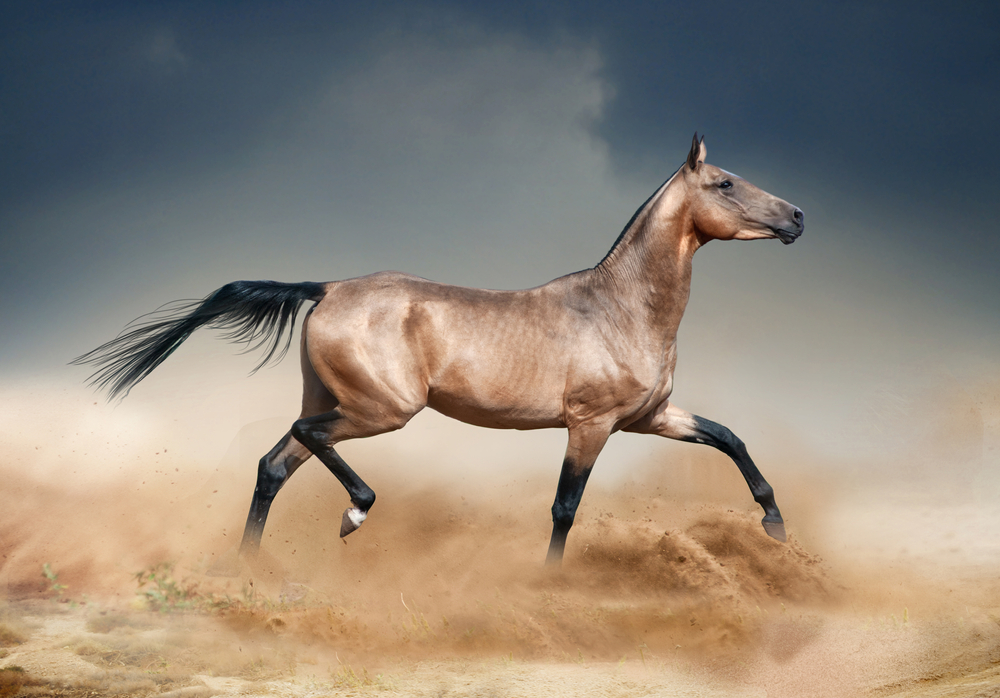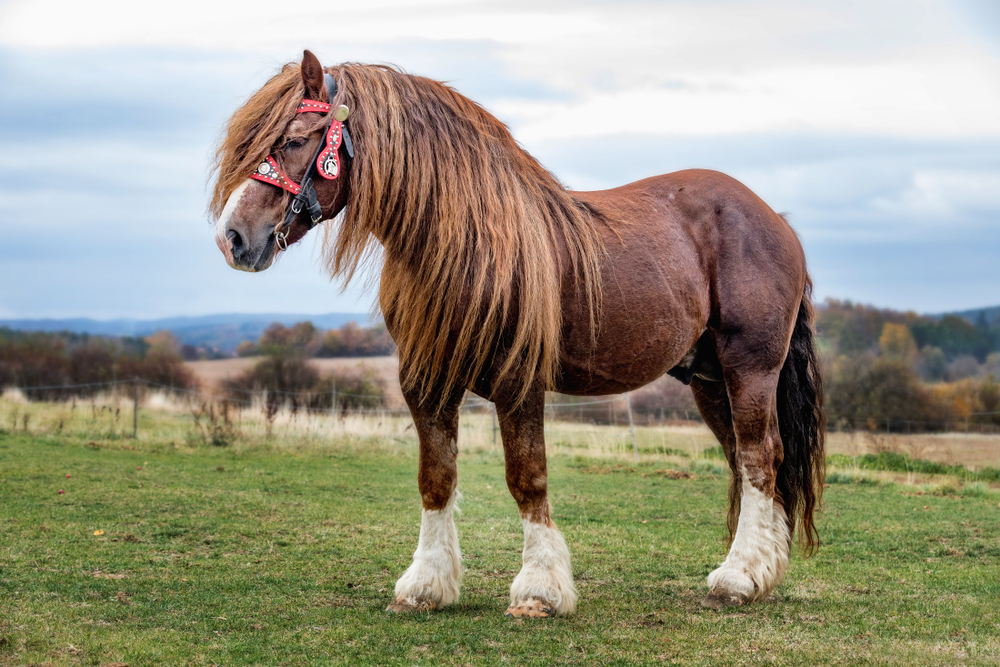- Your source for stall mats, rubber arena footing, arena harrows and arena dust control.

I have just had the pleasure of helping two of my students buy their first horses. I think they thought me to be a narrow-minded stick-in-the-mud with the number of horses they eagerly presented to me, which I advised against buying. This article explains why certain breeds of horses are not ideal for beginner riders.
The worst horse breeds for beginner riders are stubborn, bolshy, temperamental, high-maintenance horses or big moving athletes. Each horse is a unique individual, and it is possible to find the perfect beginner horses amongst novice-incompatible horse breeds and vice versa.
Experienced riders make riding look deceptively easy. Novice riders have not yet mastered the art of riding and should look for gentle, patient horses that can teach them the ropes and foster their riding confidence. Here is a list of the worst horses for beginners to buy.
1. An Arab Stallion
Arabians (often shortened to Arab) are a sensitive, brilliant horses who do not tolerate unjust or incompetent handling.
Adding the testosterone levels of a stallion to the already opinionated nature of an Arab creates a horse that only professionals should work. Stallions are often unpredictably aggressive and may accidentally or intentionally hurt a person when frustrated.
Stallions are often stabled 24/7 and kept isolated from other horses. The unnatural living conditions of stallions elevate their stress levels and exacerbate their unruly and sometimes aggressive behavior.
Arab stallions make friendly, intelligent, and highly loyal riding partners for advanced riders. However, they are not known for being beginner-safe horses.
2. A Bolshy No-Manners Percheron
Many riders are attracted to the steady, unflappable nature of the draft horses such as the Percheron. While it is true that these giants are known to be gentle, virtually bombproof horses, not all of them are suitable for beginners.
All horses are big and much more powerful than humans, but this is never more obvious than with the humungous Percheron. If the Percheron is not trained correctly from a young age, they will learn to use that strength against their puny human handlers!
Once a Percheron has braced their neck, no amount of pulling, tugging, or cajoling will convince them to change their mind.
I have seen beginner riders involuntarily taken home by the Percheron they were riding. The Percheron mare decided she was tired, and the rider had no hope of turning her around. The rider was unhurt but understandably frustrated!
Experienced riders will know how to use non-force-based techniques to gain these Percheron’s attention and respect, but these techniques can be challenging for a novice rider to master.
3. An Elite Dressage Hanoverian
Dressage-bred warmbloods like Hanoverians are known for their gorgeously extravagant movement. This movement is a breath-taking sight to behold but can be incredibly challenging to sit.
Most elite dressage riders spend many hours in the gym developing the core muscles necessary to ride these big moving Hanoverians. An uneducated person watching a skilled rider ride often mistakenly assumes that riding is easy, and the horse does all the work. In reality, good riders expend an enormous amount of energy during an intensive training session.
A novice rider rarely has the fitness, muscle control, and balance to follow an advanced dressage horse’s movement. The rider may fall off, not because they were bucked off or because the horse was naughty but simply because they can’t “stick” the big moving horses.
4. A High Maintenance Friesian
Friesians have been portrayed as the ultimate high-priced family horse. While this is true for some Friesians, it is not valid for all. Friesians are becoming more popular as dressage horses, and thus the focus of breeding has changed.
Modern Friesians are more reactive, energetic, and athletic; thus, beginners can be overwhelmed by a modern sport Friesian. In addition, to this Friesians are typically high maintenance horses to keep.
They’re prone to skin conditions, laminitis, and Aortopulmonary fistulas secondary to aortic rupture. Caring for a Friesian is time-consuming and often more technical than caring for hardy breeds like Quarter Horses and Boerperds.
Beginners should not get a Friesian unless they can rely on the advice of an experienced friend, trainer, or family member. The novice horse owner should also factor in the increased time requirements and costs of owning a Friesian.
5. An Off-The-Track Thoroughbred
Off-The-Track Thoroughbreds (OTTB) may seem like the bargain of a century! The thoroughbreds are sold for hundreds of thousands as yearlings and are often sold for a couple hundred dollars a few years later; surely that’s a good deal. Right?
Many cash-strapped horse owners have indeed found outstanding Sporthorse prospects amongst the failed racehorses, BUT it takes an experienced horse person to rehab an OTTB successfully.
Most OTTB’s have severe physical, behavioral, and training issues relating to their time on the track. An OTTB will need time to detox and learn how to be a regular horse again. These Thoroughbreds need to be retrained for pleasure riding, and until that training is complete will be dangerous for a novice rider to ride and handle.
Many OTTBs go on to be very successful in their second career and frequently become schoolmasters for novice riders to learn on.
6. A Sharp Trakehner
Trakehners are light-framed, refined warmbloods. They are popular as both elite dressage horses and eventing horses.
Their superior athleticism and the high percentage of Arab and Thoroughbred blood have made these horses into sharp, reactive, and highly sensitive rides. Many experienced riders describe their talented Trakehners as talented but quirky!
One of the best dressage horses born in the past two decades was the captivating Blue Hors Matinee ridden by Andreas Helgstrand and sired by the Trakehner stallion Silvermoon. Matinee’s reputation for sensitivity-linked explosiveness was only superseded by her out-of-the-world talent!

The Ideal Horse For A Beginner
The ideal horse for a beginner is not a specific horse breed but rather a horse that demonstrates the personality, movement, and schooling needed for a novice rider.
A beginner-safe horse is:
- Kind, gentle, and patient
- Sensible and not spooky
- Riding sound (not lame or sick)
- Does not have any vices, e.g., biting, bucking, bolting, rearing, napping, etc.
- Is tolerant of mistakes and well-confirmed in basic schooling
- Sure-footed and balanced
- Has average movement, i.e., not a big moving horse
- Hardy and robust, i.e., not a high maintenance horse
- Between 8yrs to 20yrs – these are experienced horses who are adept at dealing with new situations.
- Polite and well-mannered
- Not sharp or overly reactive
Conclusion
Buying a new horse is an exhilarating adventure to embark on! Unless you plan to compete in breed-specific shows, any breed of horse or even crossbreed can be an ideal beginner-safe horse if they meet all the criteria of a novice-suitable ride.
The ideal horse for a beginner is one that teaches them the ropes of riding while allowing the rider to have fun and gain confidence in their riding skill. Beginner-safe horses are worth their weight in gold regardless of their purchase price!


